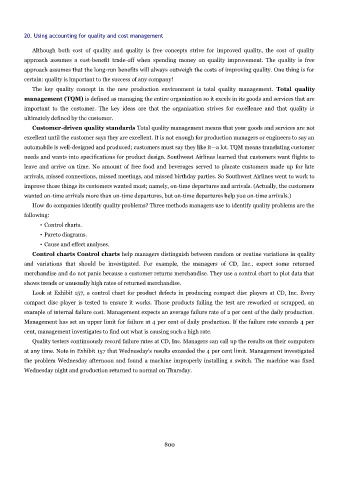Page 799 - Accounting Principles (A Business Perspective)
P. 799
20. Using accounting for quality and cost management
Although both cost of quality and quality is free concepts strive for improved quality, the cost of quality
approach assumes a cost-benefit trade-off when spending money on quality improvement. The quality is free
approach assumes that the long-run benefits will always outweigh the costs of improving quality. One thing is for
certain: quality is important to the success of any company!
The key quality concept in the new production environment is total quality management. Total quality
management (TQM) is defined as managing the entire organization so it excels in its goods and services that are
important to the customer. The key ideas are that the organization strives for excellence and that quality is
ultimately defined by the customer.
Customer-driven quality standards Total quality management means that your goods and services are not
excellent until the customer says they are excellent. It is not enough for production managers or engineers to say an
automobile is well-designed and produced; customers must say they like it—a lot. TQM means translating customer
needs and wants into specifications for product design. Southwest Airlines learned that customers want flights to
leave and arrive on time. No amount of free food and beverages served to placate customers made up for late
arrivals, missed connections, missed meetings, and missed birthday parties. So Southwest Airlines went to work to
improve those things its customers wanted most; namely, on-time departures and arrivals. (Actually, the customers
wanted on-time arrivals more than on-time departures, but on-time departures help you on-time arrivals.)
How do companies identify quality problems? Three methods managers use to identify quality problems are the
following:
• Control charts.
• Pareto diagrams.
• Cause and effect analyses.
Control charts Control charts help managers distinguish between random or routine variations in quality
and variations that should be investigated. For example, the managers of CD, Inc., expect some returned
merchandise and do not panic because a customer returns merchandise. They use a control chart to plot data that
shows trends or unusually high rates of returned merchandise.
Look at Exhibit 157, a control chart for product defects in producing compact disc players at CD, Inc. Every
compact disc player is tested to ensure it works. Those products failing the test are reworked or scrapped, an
example of internal failure cost. Management expects an average failure rate of 2 per cent of the daily production.
Management has set an upper limit for failure at 4 per cent of daily production. If the failure rate exceeds 4 per
cent, management investigates to find out what is causing such a high rate.
Quality testers continuously record failure rates at CD, Inc. Managers can call up the results on their computers
at any time. Note in Exhibit 157 that Wednesday's results exceeded the 4 per cent limit. Management investigated
the problem Wednesday afternoon and found a machine improperly installing a switch. The machine was fixed
Wednesday night and production returned to normal on Thursday.
800

